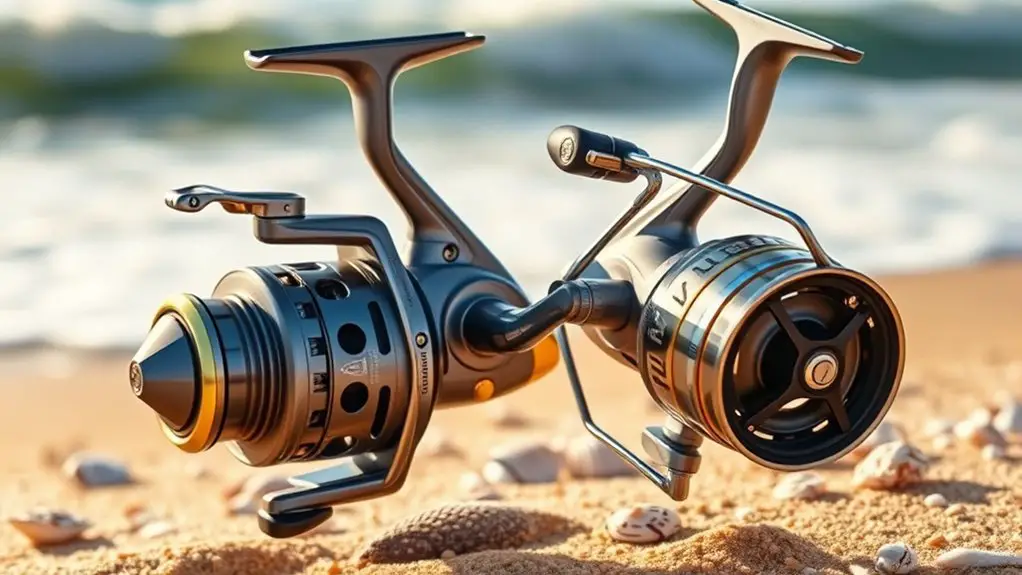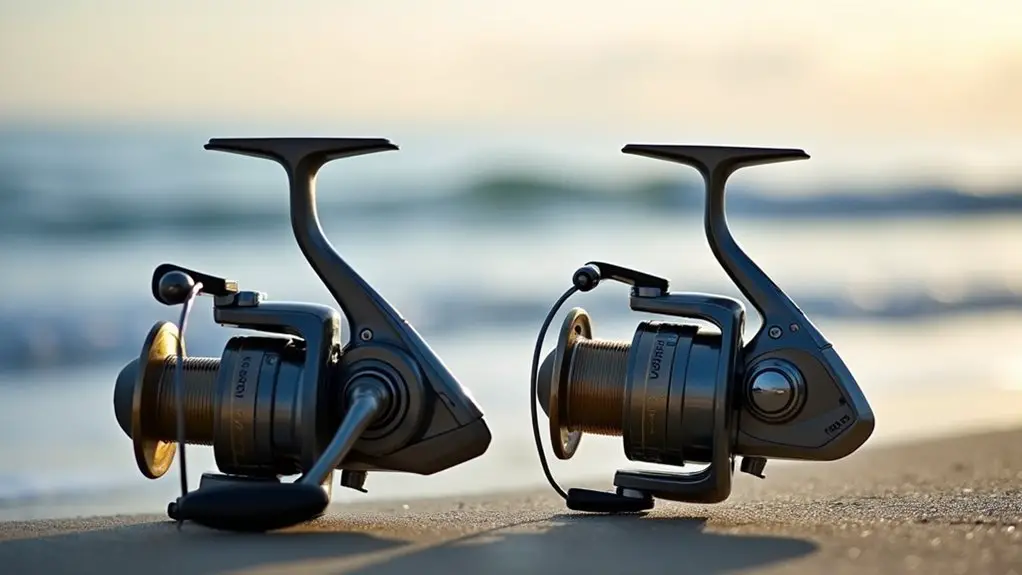Gear ratio on your spinning reel represents how many times the spool rotates per handle turn. For surf fishing, higher ratios (6.0:1+) give you faster retrieval for covering more water and chasing predatory species. Lower ratios (4.0:1-5.3:1) provide more cranking power for fighting big fish in rough surf. Consider both your target species and conditions—redfish might need a versatile 5.2:1-6.2:1, while sharks demand lower ratios for power. The perfect ratio balances your fishing style with the challenges of the surf.
Surf Fishing Highlights
- Gear ratios indicate retrieval speed, with higher ratios (6.0:1+) enabling faster lure recovery and lower ratios (4.0:1-5.3:1) providing more torque.
- Lower gear ratios deliver greater cranking power for fighting large surf species and maintaining control in rough conditions.
- High-speed reels (7.0:1+) excel for fast-moving species like Spanish mackerel, allowing quick retrieval and more casts per session.
- Line recovery rate (inches per handle turn) combines gear ratio with spool diameter to determine actual retrieval speed.
- Mid-range ratios (5.5:1-6.0:1) offer versatility for surf fishing, balancing retrieval speed with sufficient power for most conditions.
Understanding Gear Ratio: The Basics Every Surf Angler Should Know
Gearheads and novices alike, the spinning reel‘s gear ratio is your mathematical friend on the shoreline—it’s not just a random number stamped on your equipment.
That 6.3:1 marking? It means your spool rotates 6.3 complete turns with each crank of your handle.
Most spinning reels fall between 5.2:1 and 6.2:1, though some speedsters push 7.0:1. This ratio directly impacts your retrieval speed (your bait’s water ballet performance) and the muscle needed for each turn. When surf fishing for heavyweight species, consider low-speed reels![]() that provide superior torque for fighting large fish from shore. Reels with ratios in the 4:1 to 5:1
that provide superior torque for fighting large fish from shore. Reels with ratios in the 4:1 to 5:1![]() range deliver the cranking power needed when battling surf-zone predators. Modern technology has introduced dual ratio reels
range deliver the cranking power needed when battling surf-zone predators. Modern technology has introduced dual ratio reels![]() that allow anglers to shift between high and low gears for optimal versatility.
that allow anglers to shift between high and low gears for optimal versatility.
Think of it as your reel’s personality profile—matching it to your fishing style transforms frustrating days into fish-catching ones!
How Different Gear Ratios Affect Your Surf Fishing Experience
Now that you understand the fundamentals of gear ratios, let’s see how these numbers actually transform your experience on the shoreline.
Your choice between high and low ratios isn’t just technical—it’s tactical.
With a zippy 6.0:1+ ratio, you’ll retrieve lures lightning-fast (perfect for those “now-you-see-me-now-you-don’t” predatory species). Early models like Crack 300 and Penn 706Z![]() had much slower retrieves but compensated with tremendous power for fighting large fish.
had much slower retrieves but compensated with tremendous power for fighting large fish.
Speed thrills when you’re chasing predators—a 6.0:1+ ratio turns your reel into a lightning strike they never see coming.
You’ll cover more water and quickly reset after missed strikes.
Meanwhile, a slower 4.0:1 ratio gives you that muscle-bound cranking power when battling bull reds or stubborn stripers. The lower gear ratios![]() provide significant mechanical advantage when fighting larger species in rough surf conditions.
provide significant mechanical advantage when fighting larger species in rough surf conditions.
It’s like trading your sports car for a tractor—less speed, more pulling power—exactly what you need when that trophy fish is dragging you through the surf zone! For general surf fishing applications, 4000 size reels![]() offer versatility that works across various conditions and target species.
offer versatility that works across various conditions and target species.
Matching Gear Ratios to Your Target Species in the Surf
When selecting the ideal gear ratio for surf fishing, your target species should always guide your decision-making process.
Smaller surf fish (10-15 inches) thrive on lighter tackle with lower ratios—power trumps speed here. Remember that lower gear ratios provide more grinding power![]() when fighting fish in challenging surf conditions.
when fighting fish in challenging surf conditions.
Medium-sized catches like redfish or flounder? Aim for that sweet spot between 5.2:1 and 6.2:1.
Chasing the big boys (hello, sharks!) means dropping your ratio for cranking power during those marathon fights. The Penn Spinfisher Live Liner 8500 offers excellent drag strength![]() specifically designed for tackling large shark species in surf conditions.
specifically designed for tackling large shark species in surf conditions.
Meanwhile, speedsters like Spanish mackerel demand 7.0:1+ ratios to match their lightning pace. For these fast-swimming species, high-speed reels allow for rapid line recovery![]() that’s essential when mimicking fleeing baitfish.
that’s essential when mimicking fleeing baitfish.
The savvy surf angler’s secret weapon? Multiple reels with different ratios—because fish don’t read rulebooks!
Power vs. Speed: Selecting the Right Ratio for Surf Conditions

The battle between power and speed represents the fundamental tradeoff you’ll navigate when selecting your surf fishing gear ratio. Understanding when to prioritize torque over retrieval rate can make or break your surf fishing success.
- Rough surf warriors benefit from lower ratios (4.0:1 to 5.3:1) that provide muscle for wrestling stripers through crashing waves. Similar to biking uphill, lower gear ratios
 significantly reduce cranking resistance when fighting powerful fish in challenging surf conditions.
significantly reduce cranking resistance when fighting powerful fish in challenging surf conditions. - Speed demons thrive with higher ratios (6.0:1+) for quick-moving lures and maximizing cast counts.
- Versatility seekers find their sweet spot in middle ground (5.5:1 to 6.0:1) ratios.
- Spool size matters as larger diameters amplify retrieval rates, giving lower ratios extra zip.
Line Recovery Rate: Why It Matters More Than Just the Ratio Number
Many surf anglers fixate on gear ratio alone, but understanding line recovery rate provides the true measure of your reel’s real-world performance.
It’s the inches of line retrieved per crank that truly matters when you’re battling surf conditions. A reel with 40+ inches per turn lets you quickly reposition lures, respond to strikes, and avoid snags in dynamic environments. Experienced anglers often select reels with high retrieve rates![]() to maximize efficiency while fishing. Spool diameter significantly impacts
to maximize efficiency while fishing. Spool diameter significantly impacts![]() line recovery speed regardless of the gear ratio number.
line recovery speed regardless of the gear ratio number.
You’ll cover more water efficiently, maximizing your fishing time rather than waiting on slow retrieves. While higher recovery rates mean less torque (something to evaluate when hooking that trophy striper!), the trade-off is worth it for most surf situations where speed trumps raw power. Fast ratio reels with 6.2:1 and higher![]() are becoming standard for modern surf fishing techniques that demand quick line retrieval.
are becoming standard for modern surf fishing techniques that demand quick line retrieval.
Preventing Fatigue: The Connection Between Gear Ratio and Comfort
Spending hours cranking your surf fishing reel can transform an enjoyable day at the beach into a forearm-burning endurance test if you’ve chosen the wrong gear ratio.
Lower ratios (4:1-5:1) give you more mechanical advantage, requiring less effort to reel in those heavyweight challengers. This becomes especially important when dead sticking techniques![]() are employed during tough winter conditions, where patience and controlled presentations are essential.
are employed during tough winter conditions, where patience and controlled presentations are essential.
- Your wrist will thank you for choosing a 5:1-6:1 ratio for all-day comfort
- High-speed reels turn arm muscles into quivering jelly after just hours of use
- Each crank with a low-ratio reel saves precious energy during trophy fights
- Your casting accuracy stays sharp when muscles aren’t screaming for mercy
For extended fishing sessions, the smooth retrieval![]() provided by quality bearings works in harmony with your chosen gear ratio to significantly reduce fatigue during repetitive casting and retrieving actions.
provided by quality bearings works in harmony with your chosen gear ratio to significantly reduce fatigue during repetitive casting and retrieving actions.
Frequently Asked Questions
Can I Modify My Existing Reel’s Gear Ratio?
Yes, you can modify your reel’s gear ratio by swapping the main drive gear and pinion gear, but it’s not always straightforward.
You’ll need compatible replacement parts that precisely fit your reel model. The modification changes your retrieve speed and power balance—higher ratios for speed, lower for torque.
Be aware that this DIY project might void warranties and could cause mechanical issues if done incorrectly.
For surf fishing, a sweet spot between 5:1 and 7:1 usually works best!
How Do Drag Settings Interact With Different Gear Ratios?
You’re playing with fire when you ignore how drag settings interact with gear ratios.
With lower ratios (4:1-5:1), you’ll get more torque, allowing steadier drag pressure against powerful fish.
Higher ratios (6:1+) retrieve quickly but apply less torque, requiring more careful drag adjustment.
You’ll need tighter drag on high-ratio reels to compensate for reduced power, but don’t overdo it!
Do Saltwater Conditions Affect Gear Ratio Performance Over Time?
Yes, saltwater absolutely affects your reel’s gear ratio performance over time. Salt crystals and corrosion gradually wear down gear teeth, creating slop in the system.
You’ll notice your once-crisp 6.2:1 reel feeling sluggish and less responsive. Without proper maintenance (rinse after every use!), saltwater will wash away lubricants, increasing friction and accelerating wear.
High-torque situations with big saltwater fighters put extra stress on gears too. Invest in marine-grade grease and regular maintenance—your future self will thank you!
Are Higher-End Reels Better at Maintaining Consistent Gear Ratios?
Yes, higher-end reels are considerably better at maintaining consistent gear ratios.
You’ll notice their precision-machined gears with tighter tolerances reduce slippage and variance—a game-changer in unpredictable surf conditions!
Their sealed bearing systems keep salt and sand at bay (goodbye, frustrating gear hiccups), while quality materials resist wear over time.
The difference isn’t just marketing hype; it’s engineering reality.
You’re investing in predictable performance, which means more fish and less fussing with equipment adjustments.
What Maintenance Ensures Optimal Gear Ratio Performance?
To maintain ideal gear ratio performance, you’ll need to clean and lubricate your gears regularly.
Remove sand and salt (the silent gear killers!) after each outing, and apply reel-specific grease to axles and gears.
Don’t overdo it—excess lube attracts dirt! Inspect gears for wear or chipping, replacing damaged components promptly.
You’re also wise to avoid forcing the handle against heavy resistance, which can strip those precious teeth.
Proper drag settings complement your gear system, keeping your retrieve smooth and consistent.
Conclusion
You’re now equipped to choose the perfect gear ratio for your surf fishing adventures. Like selecting the right gear on a mountain bike, your reel’s ratio determines whether you’ll power through the tough spots or race across the flats. Remember, it’s not just about the numbers—it’s about matching your equipment to your quarry, conditions, and comfort. The right gear ratio isn’t just a specification—it’s your key to more successful days on the surf.

